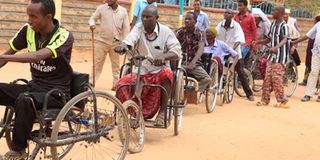People who are disabled useful to economy

Disabled people in Mandera demonstrate on August 31, 2016 after the county government failed to sponsor them to attend a sports competition in Isiolo. PHOTO | MANASE OTSIALO | NATION MEDIA GROUP
What you need to know:
- Article 27 of the convention provides that State parties shall promote employment opportunities and career advancement for the disabled, as well as offer assistance in finding, obtaining, maintaining, and returning to employment.
- The Kenya Constitution provides that the State shall ensure the progressive implementation of the principle that at least five per cent of the members of elective and appointive bodies are disabled.
Every third day of December the UN celebrates disabled people with the day dedicated to them. Globally it is estimated that 15 per cent of the population comprises disabled people. The 2009 census showed that such people make up four per cent of Kenya’s population — at the time 1,330,312 people.
The theme for this year’s international day, celebrated on December 3, was “Achieving 17 goals for the future we want”. The main focus is to review how the sustainable development goals can be used to improve the welfare of disabled people.
To secure the future of Africa, work is in place to steer African states to develop.
This was the purpose of the United Nations Millennium Development Goals of 2000, which led to the 17 sustainable goals of 2015.
However, the disabled have not been fully included in development, in the spirit of “Leave no one behind”. Sustainable goal number eight states: “Member states shall promote sustained, inclusive and sustainable economic growth, full and productive employment and decent work for all.”
Kenya signed and ratified the United Nations Convention on the Rights of Persons with Disabilities in 2008.
Article 27 of the convention provides that State parties shall promote employment opportunities and career advancement for the disabled, as well as offer assistance in finding, obtaining, maintaining, and returning to employment.
The Kenya Constitution provides that the State shall ensure the progressive implementation of the principle that at least five per cent of the members of elective and appointive bodies are disabled.
However, the unemployment rate of persons with disabilities is still high.
A study conducted by the Public Service Commission of Kenya titled Evaluation Report on Public Service Compliance with Values and Principles in Articles 10 and 232 of the Constitution, whose findings were released in January 2015, revealed that only one per cent of the Public Service Commission employees are disabled.
Out of 106,274 public service employees, only 1,082 were disabled.
The World Report on Disability, released by the World Bank and the World Health Organisation in 2011, revealed that unemployment is a major challenge for the disabled.
The World Health Survey results for 51 countries give employment rates of 52.8 per cent for disabled men and 19.6 per cent for women in the same predicament, compared with 64.9 per cent for non-disabled men and 29.9 per cent for non-disabled women.
The disabled in Kenya are yet to fully enjoy access to equal job opportunities and the implementation of the constitutional principle of five per cent of jobs in elective and appointive bodies.
Most disabled people are languishing in poverty and struggling to get decent employment.
This state of inequitable access to employment opportunities is a major impediment to development.
Lack of data on this segment of the population makes it even more difficult to include the disabled in national development plans.
If this is left unaddressed through effective policy implementation and monitoring, it could lead to failure to attain development goals and exclusion.
Ms Omino is a Masters student at the University of Nairobi. [email protected]





